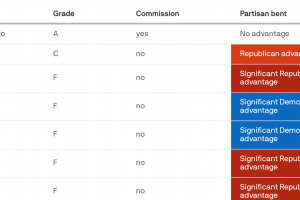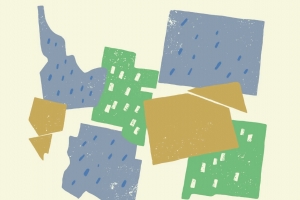Perspectives: How Partisan Redistricting Will Influence the Next Decade of US Politics
Summary from the AllSides News Team
States and legislators across the country are hard at work on manipulating their election district maps. How will that shape the next ten years of partisan politics?
Every 10 years, each state redraws its political lines based on the U.S. Census data. These redistricting processes — which are known as gerrymandering when they favor one party — take months to complete and heavily influence the balance of power in Congress for a decade. In Texas and Ohio, the redrawn maps are expected to boost Republicans, who control the redistricting process in those states. In Illinois and Maryland, where Democrats oversee the redrawing of maps, their party is expected to benefit from the redistricting process. Forty-four states are redrawing maps this year — the remaining six only have one seat in the House of Representatives, so redistricting is unnecessary.
Outlets across the spectrum have highlighting the ongoing redistricting process. Coverage on all sides pointed out how state maps drawn by an independent commission generally receive much higher grades for fairness than maps drawn by partisan state lawmakers. Some coverage from right-rated sources highlighted controversy surrounding Maryland's map. One writer for National Review (Right bias) condemned the partisan methods of redistricting, and was joined by other voices across the spectrum in calling for the entire process to be rethought. Updated 12/15/21 at 2:59 p.m. ET to be clearer about the distinction between redistricting and gerrymandering.
Featured Coverage of this Story
From the Left
States are redrawing every congressional district in the U.S. Here is where we stand.
Every 10 years, each state redraws its political lines. These processes take months to unfold in state capitals all around the country — and their results mold the balance of power in Congress for a decade.
Our analysis uses local voting tallies and Census data to decode what these new lines mean. We'll update this report as states approve new maps — and for up-to-the-minute redistricting news, be sure to subscribe to Weekly Score.
Using 2020 presidential election data, we're taking individual voting precincts and stacking them together to rebuild each state's congressional...
From the Left
Congressional mapmakers receive "F" grade in five states
Partisan legislators across the country have been busy manipulating district lines to bolster their party's chances of controlling the House next year, according to analysis of maps by the Princeton Gerrymandering Project and RepresentUs.
By the numbers: Nineteen states have now finished the redistricting process, and Georgia, New Mexico and Virginia are awaiting only a final signature on their plans. The Redistricting Report Card project has released grades for seven of these 22 maps. Five received an F.
Six of the remaining 28 states do not have congressional redistricting, as they...
From the Center
How redistricting will shape politics in the West for the next decade
States across the West are finalizing their new election district maps for the next decade based on 2020 U.S. Census data, and their decisions will have far-reaching consequences.
In California, Republican Rep. Devin Nunes announced he won’t seek reelection after redistricting put him in a much more competitive district, exchanging a shot at the chairmanship of the influential House Ways and Means Committee to work for former President Donald Trump’s new media company. In Oregon, where Democrats control the redistricting process, they reduced the number of competitive districts for Republicans, while Utah...
AllSides Picks

April 18th, 2024

April 17th, 2024


More News about Elections from the Left, Center and Right
From the Left
From the Center
From the Right




